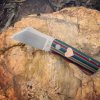Sean Yaw
Gold Member
- Joined
- Feb 26, 2019
- Messages
- 417
I finished up my sixth knife tonight and have an issue I am looking for help/insight into. When I am peening a knife together, I start with the pivot and try to get it just tight enough to eliminate side to side play. The problem is when I accomplish that, the blade tightens up (sometimes fairly significantly) as it is closing. So, just tight enough when open and quite tight as it closes. This is leading to challenges, especially with lockbacks that don't have as much spring pressure to close as slipjoints do (at least mine). I am using precision ground steel straight on 410 liners (i.e., no mill relieving or washers). It seems reasonable that there would be more friction as the blade closes and the top of the tang enters the liners, but there is much more resistance than GEC and other factory slipjoints I have handled. Any idea what my issue is and how I could address it? Thank you.

